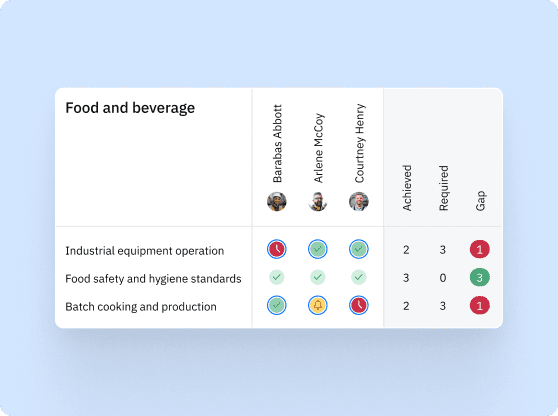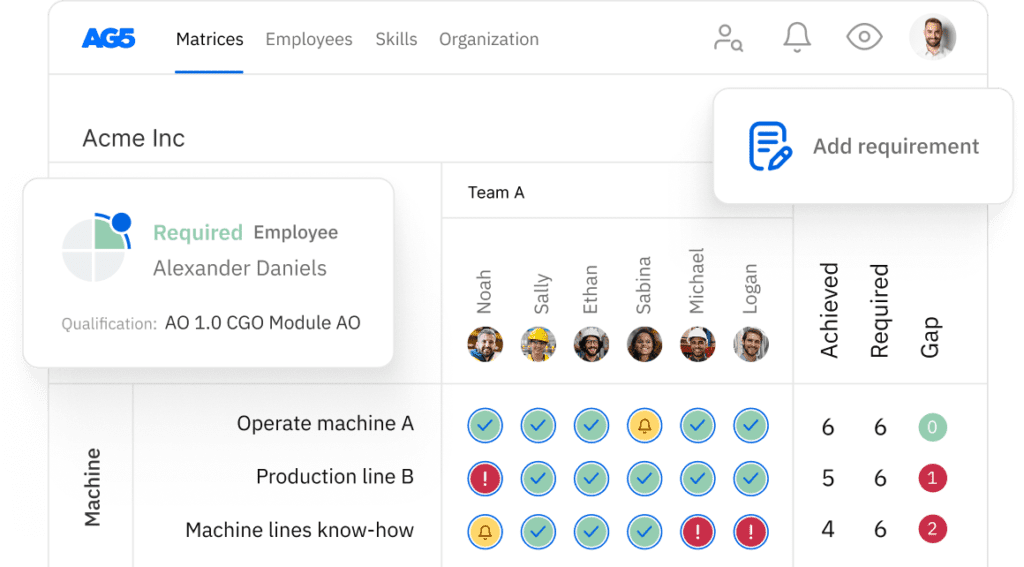How to conduct a skills gap analysis
In this article, we discuss how to conduct a skills gap analysis. It provides a comprehensive guide and actionable steps for identifying and addressing skill gaps within organizations effectively.

How to conduct a skills gap analysisCopied
Conducting regular skills gap analyses helps you ensure that your teams are built and operating at their fullest potential. By measuring the skills your employees have against those that your organization needs, you can better plan for the future, ensure regulatory compliance, and avoid costly production delays.
In this article, we’ll provide you with everything you need to know to conduct an effective skills gap analysis. We’ll also show you how AG5 can simplify the process with an intuitive platform that makes identifying and closing skills gaps easier than ever.
What is a skills gap?Copied
A skills gap refers to the difference between the skills employers seek in their employees or candidates, and the skills that those employees or candidates possess.
Skills gaps might be the result of a lack of training, education, or experience, or occur because certain certifications have expired. Regardless, skills gaps can potentially cause production delays, result in a lack of compliance with regulatory standards, or make the workplace otherwise unsafe. All of these have financial ramification; a Deloitte report, for example, reveals that skills gaps cost the US economy $500 billion each year [1].
This means that identifying and closing skills gaps in your organization is critical. One way to do so is with a skills gap analysis
What is a skills gap analysis?Copied
A skills gap analysis is a method to analyze your employees’ skills, qualifications, and certifications against those your organization requires or needs.
Done correctly, a skills gap analysis will provide business leaders and managers with actionable insights they can use to improve or develop employees’ to better meet business goals.
Generally, there are two types of skills gaps: organizational and individual.
- Organizational skills gap analysis focuses on business as a whole, evaluating of the collective skills of employees and teams to determine whether they meet the organization’s needs
- Individual skills gap analysis focus on individual employees. They assess whether they have the skills or certifications they need to effectively perform their roles
The business impact of skills gaps in the organizationCopied
We’ve touched on this above, but let’s take a closer look at exactly how skills gaps can affect an organization.
Decreased productivity
Organizations experiencing skills gaps often see significant declines in productivity. When employees lack essential skills, they struggle to complete tasks efficiently, leading to slower project timelines and reduced overall output. Companies that effectively realign their HR processes to close these gaps can increase productivity by as much as 40%. [2]
Lost revenue
Skills gaps may leave 2.4 million positions may remain unfilled in the United States, which could have a potential negative economic impact of $2.5 trillion [3]. This is partially due to a lack of in-housing training or reskilling programs, as well as to the emergence of new technologies.
Reduced competitiveness
Companies that do not address their skills gaps risk falling behind in innovation and market responsiveness. [4] In turn, this can result in lost opportunities and a weaker position against competitors who have more skilled and adaptable workforces
Lower employee engagement
When employees don’t feel they can adequately perform their jobs, their job satisfaction and engagement levels decline. This can lead to higher turnover rates and difficulties in retaining top talent. Properly addressing skills gaps can improve employee engagement by up to 50%, according to McKinsey.
How to conduct a skills gap analysis: Step by stepCopied
Regardless of whether the skills gap analysis you want to perform is at the organizational or individual level, you need to determine which skills you require, assess your current skills, and then close the gaps between the two.
Define organizational goals
Begin by clearly defining your organization’s short-term and long-term goals. This will help you fully understand what your organization aims to achieve. You should also identify the critical roles and functions that directly contribute to meeting these goals.
Identify required skills and competencies
First, you’ll need to determine the skills and competencies (as well as certifications and qualifications) your organization and its employees need to achieve their goals. You can do this on a project-by-project, team-by-team, organization-wide basis.
Good questions to ask here include:
- What certification is required to run specific machinery?
- What skills are necessary to perform individual roles?
- What emerging technologies or industry trends should we be prepared for, and what skills are necessary to adopt them effectively?
- Which soft skills are essential for enhancing team collaboration and overall performance?
- What are the critical success factors for our key projects, and what specific technical or domain expertise do we need to achieve them?
Assess current skills
Now, you’ll need to assess the skills and qualifications that your employees have. To do so, you should perform a skills assessment.
You can also use tools such as surveys, questionnaires, self-assessments, and performance reviews (more on this below) to gather information on the skills your employees currently have.
Additionally, you can create a skill matrix that maps out employees’ current skills against the required competencies for their roles. This helps in visualizing the gaps.
Analyze skills gaps
Analyze the data collected to identify where any gaps may exist. You should focus on areas where the gaps are most significant – or where they directly impact your organization’s most important goals.
A good move here is to rank any existing skills gaps by their impact on achieving organizational objectives. This will help you focus your resources on the most critical areas.
Develop a plan to close skills gaps
Based on the skills gaps you’ve identified, you can now develop targeted training programs for your employees and teams. It’s important not to think solely of your organization at this step.
Instead, try to focus more on how you can upskill or reskill employees in ways that align their career goals with your organization’s needs. This will help keep your employees happy and engaged as you move ahead. Additionally, if you need a skill urgently, you can also consider recruiting new talent.
Tools for conducting a skills gap analysisCopied
You can use a variety of tool to ensure a thorough and accurate skills gap analysis. These range from qualitative methods like interviews to quantitative approaches such as surveys and skills matrices, each of which can be advantageous in identifying skills gaps and developing targeted training or upskills plans that can help you close them.
Tools that can help you accurately and effectively conduct a skills gap analysis include:
- Employee interviews, which give you a first-hand account of the rationale for decision-making
- Performance reviews and self-assessments, providing clear indicators of ability and progression within a role
- Surveys and questionnaires, offering honest insight into employee performance, especially if conducted anonymously
- Skill matrices – a powerful visual aid for analysis on both the macro and micro level
Close the skills gap with AG5 skills management softwareCopied
AG5 provides you with an easy-to-use platform you can use to conduct skills gap analyses, then identify and close skills gaps. Your sites, departments, teams, and employees can also use our software to stay aligned, continuously improve, develop recruitment and upskilling initiatives, drive employee engagement, and more.
You can use AG5 to:
- Map the skills, knowledge, and competences present in your organization – as well as those that your employees need
- Replicate complex organizational structures with drag-and-drop menus
- Find the best replacements for employees off sick in a single search
- Enter updates and training results from the shop floor in real time
- Match projects to specific employees’ expertise and experience
Want to see how it works? Schedule a free, live, 15-minute demo for a customized look at what AG5 can do for your organization.
Sources Copied
- Change view: Table
-
APA
| # | Source title | Description | Publication | Retrieved | Source URL |
|---|---|---|---|---|---|
| 1 | The jobs are here, but where are the people? | Deloitte Insights | November 14, 2018 | October 3, 2024 | https://www2.deloitte.com/us/e.. |
| 2 | Using skill gap assessments to help future-proof your organization | McKinsey | May 23, 2022 | October 3, 2024 | https://www.mckinsey.com/capab.. |
| 3 | The Skills Advantage | December 16, 2021 | October 3, 2024 | https://learning.linkedin.com/.. | |
| 4 | Skills gap in manufacturing study | Deloitte | November 13, 2018 | October 3, 2024 | https://www2.deloitte.com/us/e.. |

